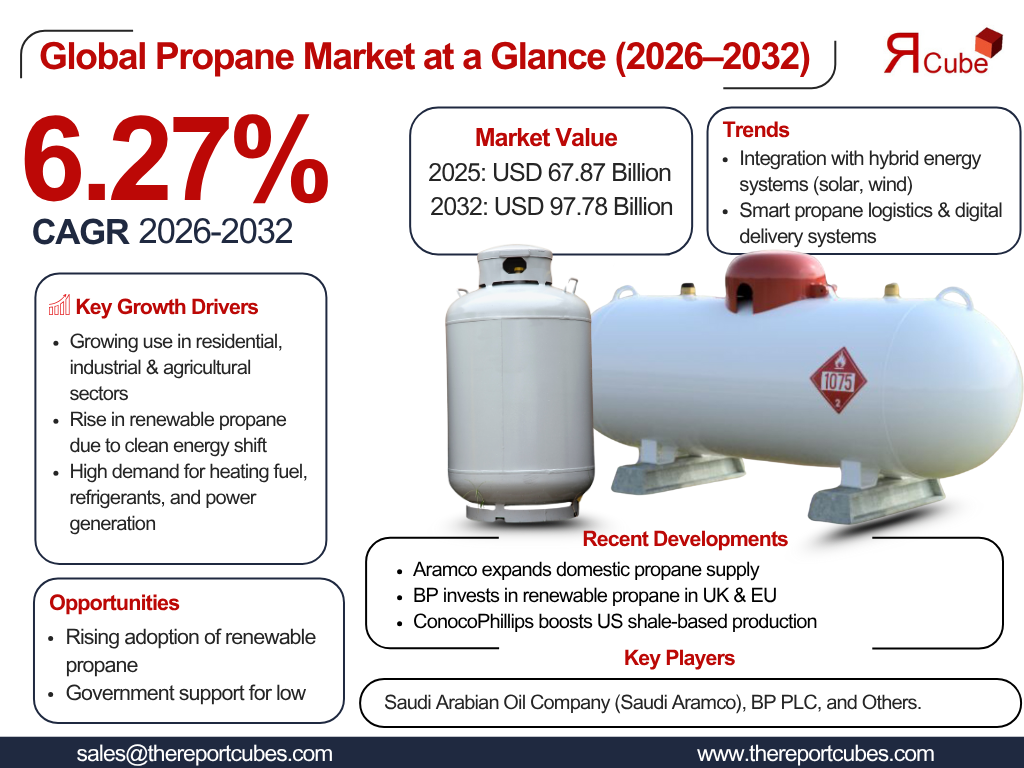Autogas, Heating & Beyond: How the Propane Market is Set to Expand by 2032

Introduction
The global propane market is experiencing steady growth, driven by its versatile applications across residential, commercial, industrial, and agricultural sectors. Propane, also known as liquefied petroleum gas (LPG), is a clean-burning fuel that serves as an efficient energy source for heating, cooking, transportation, and power generation. According to The Report Cubes, the propane market was valued at USD 67.87 billion in 2025 and is projected to reach USD 97.78 billion by 2032, growing at a CAGR of 6.27% during the forecast period (2026–2032).
This article explores the key factors influencing the propane market, its major applications, regional trends, and future growth opportunities.
Market Overview and Key Drivers
1. Increasing Demand for Clean Energy
Propane is considered an eco-friendly alternative to traditional fossil fuels like coal and gasoline. With growing environmental concerns and stringent regulations on carbon emissions, industries and households are shifting toward cleaner energy sources. Propane emits fewer greenhouse gases, making it a preferred choice for:
- Residential heating and cooking
- Autogas (vehicle fuel)
- Industrial processes
2. Growth in Residential and Commercial Use
In regions with limited access to natural gas pipelines, propane is widely used for:
- Home heating
- Water heating
- Cooking fuel
- Power backup solutions
The rise in urbanization and infrastructure development in emerging economies is further boosting demand.
3. Expansion of the Automotive Sector (Autogas)
Propane is gaining traction as Autogas (LPG for vehicles) due to its cost-effectiveness and lower emissions compared to gasoline and diesel. Countries like Turkey, South Korea, and Poland have a strong Autogas market, supported by government incentives.
4. Agricultural and Industrial Applications
- Agriculture: Propane is used in crop drying, pest control, and irrigation pumps.
- Industries: It serves as a fuel for forklifts, furnaces, and metal cutting.
Market Segmentation
The propane market can be segmented based on application, end-user, and region.
1. By Application
- Residential (Heating & Cooking)
- Commercial (Hotels, Restaurants, Hospitals)
- Industrial (Manufacturing, Petrochemicals)
- Transportation (Autogas)
- Agriculture
2. By End-User
- Households
- Businesses
- Industrial Sector
- Government & Municipalities
3. By Region
- North America (Largest Market – U.S. & Canada)
- Europe (Strong Autogas Adoption – Turkey, Poland, Italy)
- Asia-Pacific (Fastest Growth – China, India, Japan)
- Latin America (Brazil, Mexico)
- Middle East & Africa (LPG for Cooking & Power Generation)
Regional Insights
1. North America Dominates the Market
- The U.S. is the largest consumer of propane, driven by residential heating and agricultural demand.
- Canada also contributes significantly due to its cold climate and reliance on propane for heating.
2. Europe: Strong Autogas Adoption
- Countries like Turkey, Poland, and Italy have high Autogas vehicle penetration due to tax benefits.
- The EU’s push for clean energy alternatives supports propane demand.
3. Asia-Pacific: Fastest-Growing Market
- China and India are major consumers due to urbanization and government subsidies for LPG.
- Rising industrialization and agricultural activities further boost demand.
4. Middle East & Africa: Expanding LPG Use
- Propane is widely used for cooking and power generation in off-grid areas.
- Government initiatives to replace traditional fuels (wood, kerosene) with LPG drive growth.
Challenges and Restraints
Despite its growth, the propane market faces some challenges:
- Price Volatility: Propane prices fluctuate based on crude oil and natural gas markets.
- Competition from Natural Gas & Renewable Energy: In regions with natural gas pipelines, propane demand may decline.
- Infrastructure Limitations: Lack of storage and distribution networks in rural areas can hinder market growth.
Future Outlook (2026–2032)
1. Rising Demand in Emerging Economies
- Countries like India, China, and Brazil will drive market expansion due to urbanization and energy needs.
2. Technological Advancements
- Smart propane tanks with IoT monitoring for efficient fuel management.
- Bio-propane (Renewable Propane) as a sustainable alternative.
3. Government Policies & Incentives
- Subsidies for Autogas vehicles and clean cooking fuel programs will support market growth.
4. Expansion in Off-Grid Energy Solutions
- Propane-powered microgrids for remote areas without electricity access.
Conclusion
The global propane market is set for robust growth, with an expected CAGR of 6.27% from 2026 to 2032. Factors such as rising demand for clean energy, expansion in Autogas, and increasing residential & industrial applications will fuel this growth. While challenges like price volatility and competition from renewables exist, technological advancements and government support will create new opportunities.
- Art
- Causes
- Crafts
- Dance
- Drinks
- Film
- Fitness
- Food
- Spellen
- Gardening
- Health
- Home
- Literature
- Music
- Networking
- Other
- Party
- Religion
- Shopping
- Sports
- Theater
- Wellness
- Script
- App
